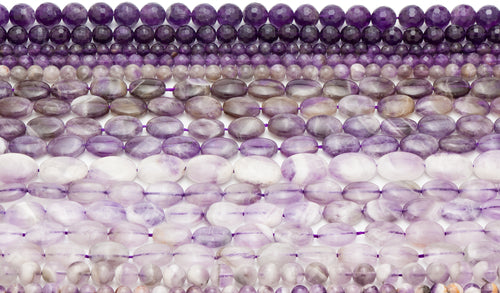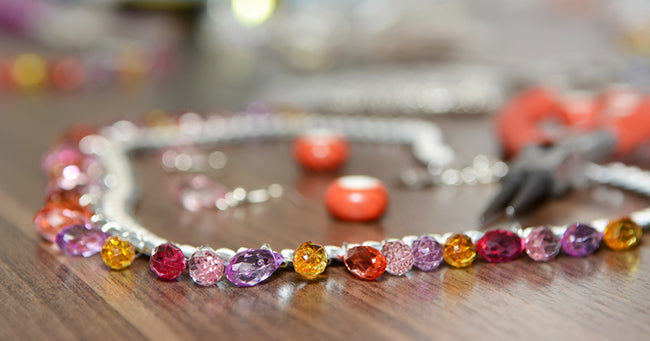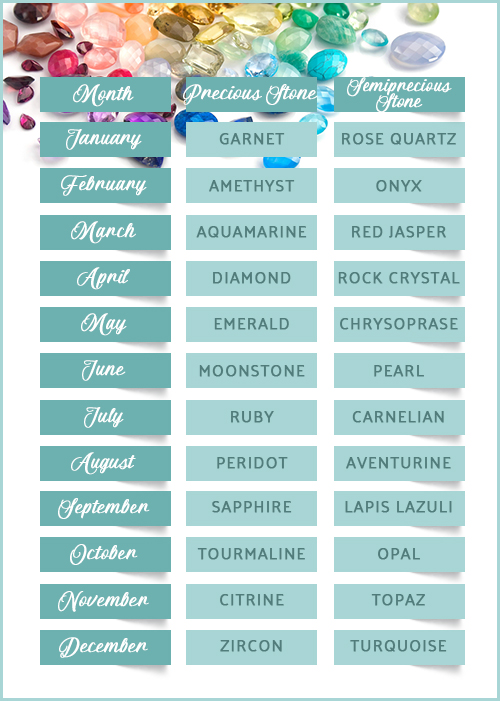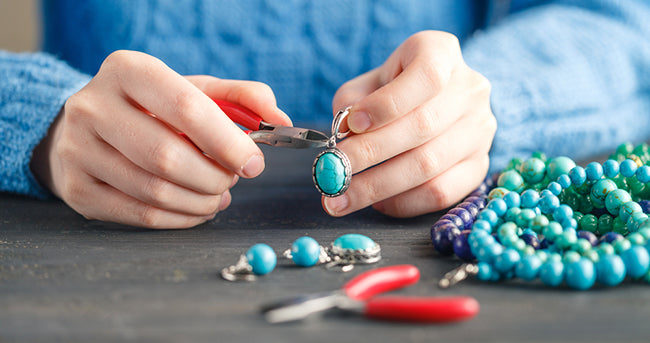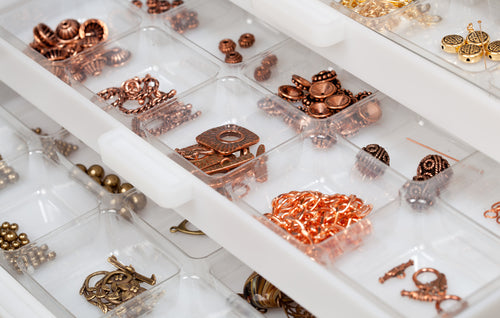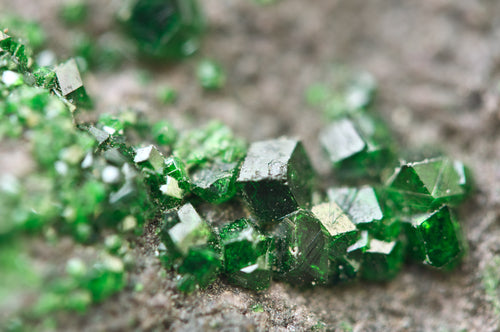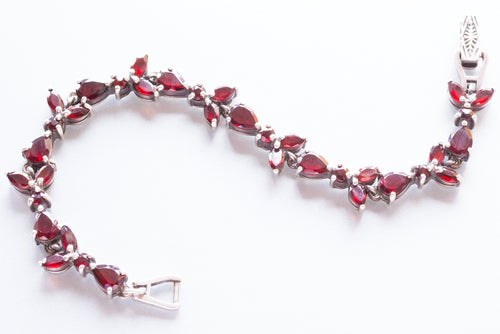Gemstone beads are meant to pop from a jewelry piece. They are often boldly-colored, dynamic in different lights or subtly elegant.
Whether you are choosing a gemstone to wear with an outfit, or if you are drawn to a piece of gemstone jewelry for its dazzling colors, you want your bracelet, necklace, earrings or rings to complement your style and maybe even be a conversation piece.
Metallic beads are an excellent way to either subtly contrast gemstones or enhance them, depending on the chosen gemstones and metal beads. They come in an array of different colors, designs and finishes, making them quite versatile for use with various gemstones.
However, that same variety can also make finding the right color and finish of metallic beads to mix with your gemstones somewhat overwhelming.
After all, if you are looking to incorporate a focal bead into your jewelry piece, you want to choose metallic beads that will help draw attention to that one, dynamic piece, not detract from it.
A little knowledge of basic color theory can help you as you shop for beads to integrate into your jewelry. With the right choice of a metallic bead, you can greatly enhance the look and quality of your gemstone jewelry, making it a favorite piece in your jewelry box for years to come.
Basic color theory
If you are not sure which metal bead colors will look best with your gemstone, the first thing to do is familiarize yourself with basic color theory.
Basic color theory encompasses three important aspects: the color wheel, color harmony and how colors are used in context. The color wheel, color harmony and color context are important in jewelry-making, but they are also important for when you are looking to redecorate your home or paint a room, among other scenarios, making it a nifty bit of knowledge.

In matching colors, it is important to find colors that enhance each other and do not clash. The color wheel presents a logically arranged sequence of “pure” hues, which gives us a sense of which colors are available and the gradations of those colors.
For instance, the color wheel presents the many hues of the color blue: from navy blue to cerulean to turquoise. The wheel displays many options for each color and their gradations from light to dark.
Color harmony is the next part of the basic color theory. Color harmony puts forward the natural harmony of colors based on three areas: analogous colors, complementary colors and nature.
Analogous colors sit next to each other on the color wheel, and the mix of the two colors create a pleasing effect on the eye when seen together. Complementary colors sit opposite one another on the color wheel and, as their name dictates, they complement one another well when used together. Complementary and analogous colors are excellent choices for creating harmonious color schemes.
Finally, looking around at examples in nature can be a powerful way to identify colors that are in harmony with one another. Colors that occur naturally together in the woods, in fields or in the sky will often reflect nicely in your jewelry or decorating options.
The final aspect of the basic color theory is looking at how colors are used in context. This refers to placing one color within the other.
For example, use one color as a background for the other and see how the two look in conjunction with one another. If the color in the foreground washes out or appears to be in direct contrast with the background color in a displeasing way, the two colors do not belong together.

With metal beads, looking at the context of your gemstone against the background created by the metallic beads will be important. Unless you are crafting a piece of jewelry solely made up of metallic beads, you will want your gemstones to stand out and not clash with the metallic hues beside or around them.
Utilize what you learn from basic color theory when choosing which metal beads to use with your gemstones. For example, you likely will not want to match a lemon quartz bead with gold metal beads because they will clash and one will wash the other out completely.
However, matching a lemon quartz bead with a darker copper bead or gunmetal will make both colors pop significantly. The contrasting darkness in the designs of copper metallic beads mixed with the yellow of lemon quartz beads also mimics the black-and-yellow of bees and other insects found in nature, which aligns it with basic color theory.
Remember, you are looking for harmony between the beads, and you want something that will be pleasing to the eye.
Which metals go best with your gemstone?
Since as early as 25,000 years ago, jewelry has been an important part of ornamenting the human body across various cultures.
Throughout our ancient human history, precious gemstones have been thought to protect against illnesses and evil spirits. For the wealthy kings and queens, gemstones were a symbol of power, authority and family traditions.

Today, gemstone colors are often selected and used in jewelry for their connotating birthday month, and as they fall in and out of trend. Perhaps not quite as magical and wealth-oriented as they once were, gemstones are still an important piece of any complete jewelry collection.
Metal beads are an excellent way to complement and enhance the look of a gemstone in a jewelry piece. Some finishes of metal look better with different gems, and it is essential to know–before selecting metal beads for your gemstones–which finishes will enhance the colors of your piece and which ones will clash.
The following is a simplified breakdown of different hues and their metal allies:
- Reds: gold, brass and silver
- Oranges: Silver and sometimes copper
- Yellows: Silver, sometimes copper, gunmetal and antique brass
- Greens: Gold, brass, silver and sometimes copper
- Blues: Gold, brass, silver and copper
- Purples: Gold, brass, silver and sometimes copper
- Whites: Gold, brass, silver, copper, gunmetal and antique brass
- Blacks: Gold, brass, silver and copper
- Browns: Gold, brass and silver
- Grays: Gold, brass, silver and copper
Gold and brass
The shine and hue of a rich gold or brass bead can elevate the look of a gemstone to new heights and enhance the overall impression of the jewelry piece.
Gold and brass complement a myriad of colors, but if you use the basic color theory and color wheel, you can get a better sense of which colors will match well with gold and brass.
As a warm tone, gold looks especially nice when paired with earth tones, such as amber, granite, sage, beige, moss green and light or dark browns. Pastel colors are also excellent colors to pair with gold and brass, including peridot, rose, azure and lavender.
Bright primary colors such as red and blue are also excellent pairs to gold, although the finish of the gold or brass should be considered with the gemstone beforehand.

Sterling silver
Silver is one of the most versatile jewelry metals because it matches and enhances almost any hue. The dynamic light-catching aspects of sterling silver make it a favorite jewelry neighbor for nearly every gemstone color.
In fact, silver can even complement other metallic colors, such as gold, brass and copper. However, silver does not look as good with the neon hues of metallic beads, as the two seem to almost compete for the spotlight and neon stones may be better served by gold, brass or copper beads.

Copper
The patterns in many copper beads lead to darker crevices and patterns in the finish of the metal, which creates a striking contrast with the brighter copper tint.
This makes it an excellent pair with bright colors and light pastels, and copper pairs especially well with turquoise and mint greens. It can be used to contrast with black and white and the primary colors of red, yellow and blue.
Copper stands up well next to silver, but not especially well against gold. If silver is mixed in with copper and gold, the three hold their own together in a piece quite nicely.
Brown hues, however, do not match with copper, as the two colors tend to wash each other out.

Gunmetal and antique brass
While not as popular as gold, brass, silver and copper, gunmetal finish beads are another option for your jewelry pieces.
Gunmetal is usually a black or dark silver colored bead. It makes an excellent complement to bright gemstones and primary colors, especially yellow, but it does not pair well with darker hues.
The gunmetal finish should be paired with brilliant colors, as the contrast between the dull tone of the gunmetal and the brilliance of the stone makes the gemstones stand out.
Antique brass is another metallic bead color that is darker in hue, and it is usually available in a dark brown. This color typically follows the same color rules as beads with a gunmetal finish.

Focal beads
Focal beads are an interesting twist to add to any jewelry piece.
On a necklace, a focal bead should draw the eye to the middle of the piece while complementing the stones and metal beads around it.
Focal beads often come in interesting shapes, patterns or multiple colors, making it a bit more challenging to match with metal beads. However, when done correctly, focal beads can enhance the metal beads and the overall impression of the jewelry piece.
Some focal beads already come set in a metal setting, making it easier to select metallic beads that match it for the jewelry piece.
Other focal beads are made of moonstones and opals, with iridescent colors that change in the light. These are whitish in appearance and go well with gold, brass or silver beads.
Solid black focal beads, while striking, represent a greater challenge. Their lack of brilliant color means that metallic beads must be selected to enhance the focus on the focal bead. Set next to gold and silver metallic beads, the stark contrast between the two colors is sure to draw the eye to your focal piece.
Enamel-plated brass beads
Enamel-plated brass beads are yet another way to enhance focal gemstones. Enamel-plated brass beads add more subtlety of colors throughout a jewelry piece, making the focal beads or gemstones stand out more.
For example, dark colors, such as burgundy or black that are paired with a yellow brass can be spaced by gold or brass beads and go well with a bright gemstone or brilliant focal bead.
The brass designs in these beads can be used as a focal point on their own as well, but when paired with a bright gemstone or focal bead, they really add to the overall impression of your jewelry.
Birthstones
Birthstones are one of the most popular choices for gemstone pieces in jewelry, and most look particularly exquisite when they are accompanied by metallic beads.

Birthstone jewelry is an excellent gift for that special someone, or for any occasion that merits sentimentality. The birthstones pair well with the following metallic bead colors beside them:
-
January–Garnet: gold, brass and silver
-
February–Amethyst: gold, brass and silver
-
March–Aquamarine: gold, brass, silver and copper
-
April–Diamond: gold, silver, gunmetal and antique brass
-
May–Emerald: gold, brass and silver
-
June–Pearl: gold, silver and gunmetal; Alexandrite: gold, brass and silver
-
July–Ruby: gold and silver
-
August–Peridot: gold, brass and copper
-
September–Sapphire: gold, brass and silver
-
October–Opal: gold, brass, silver and copper; Tourmaline: gold, silver, gunmetal and copper
-
November–Citrine: some hues of gold, silver and some copper; Topaz: silver
-
December–Tanzanite: gold, brass, silver and copper; Turquoise: gold, brass, silver, gunmetal, antique brass and copper; Blue Zircon: gold, silver and copper
Remember, rather than adding distraction, the metal beads on birthstone jewelry should be background colors for the gemstones. They should subtly enhance the gemstone’s color without taking over the piece so the gemstone shines.
Final thoughts

Metal beads are one of the subtlest yet creative ways to instantly enhance a piece of jewelry and make the gemstones or focal beads of a piece of jewelry stand out.
Metal beads can be used as spacers throughout a piece, alternating between the gemstones in a bracelet or necklace. They can also be used to frame the focal piece, drawing the eye to the central bead. Just like a frame accentuates a piece of art without detracting from it, metal beads should support the gemstones and focal beads and, overall, be a part of the background of the piece.
Utilizing the color wheel and basic color theory can help you make the best choices when it comes to choosing metal beads for your gemstone jewelry. By dedicating just a little bit of time to compare and plan, you can craft a bracelet, necklace, ring or set of earrings that feature both metallic beads and precious gemstones that will be timeless favorites in your jewelry collection.







